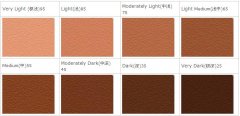Practical raw bean knowledge
The original species of Arabica can be divided into washing type (washed) and non-washing type (Unwashed) (it is correct to say that the original Robusta species can also be distinguished in this way, except that the original robusta species are rarely washed). In the raw capital state, the endocarp part of the central fissure (center cut) is brown yellow, which is treated by non-washing refining method, while the grayish green ones are treated by washing refining method. After baking, if the central line (center line) of the central crack (center cut) of the tea-brown coffee bean is white, and the white Silver Skin (silver seed coat) still remains, it means that the refining method is washed with water, while if the central line and other parts are brown with tea, and then almost no white Silver Skin remains, the refined hair is non-washed (natural drying).
If new crop (beans produced in that year), the average moisture content of raw beans with water washing is less than 12%, while that of non-washing beans is about 11%. If the raw beans contain more than 14% moisture, because the green beans look black, they will often turn white in a very short period of time and lose the original flavor of the coffee, so pay special attention to it.
Important Notice :
前街咖啡 FrontStreet Coffee has moved to new addredd:
FrontStreet Coffee Address: 315,Donghua East Road,GuangZhou
Tel:020 38364473
- Prev

Baking degree resolution diagram
American Coffee Association (SCAA) roasting standard this standard uses infrared caramelization tester technology (Agtron) to measure the color of coffee beans to determine the roasting degree of coffee, and the color is divided into eight equal parts into eight standard color blocks for coffee industry as roasting identification.
- Next

Characteristics of coffee beans at different roasting stages
Light the most mild baking, no fragrance and concentration can be said to test light for the general popular baking degree, leaving a strong sour taste. The cinnamon color of beans is favored by people in the western United States. Medial is moderately baked. Mellow, sour and delicious are mainly used in blended coffee with moderate High acidity and bitterness. It is suitable for coffee such as Blue Mountain and moving Mazaro for Japanese and Nordic people.
Related
- Guji coffee producing area of Guji, Ethiopia: Humbela, Shakiso, Wulaga
- What is the most expensive variety of Qiloso in BOP multi-variety group?
- How to store the coffee beans bought home?
- Why are Yemeni coffee beans so rare now?
- Ethiopian Sidamo all Red Fruit Sun Sun Santa Vini Coffee beans
- SOE is mostly sour? What does it mean? Is it a single bean? what's the difference between it and Italian blending?
- Is Italian coffee beans suitable for making hand-brewed coffee?
- How to choose coffee beans when making cold coffee? What kind of coffee beans are suitable for making cold coffee?
- Just entered the pit to make coffee, what kind of coffee beans should be chosen?
- Can only Japan buy real Blue Mountain Coffee? What are authentic Jamaican Blue Mountain coffee beans?

